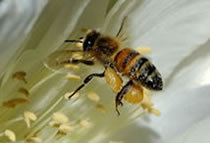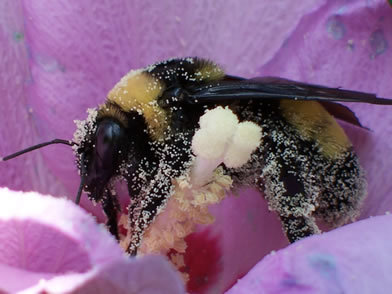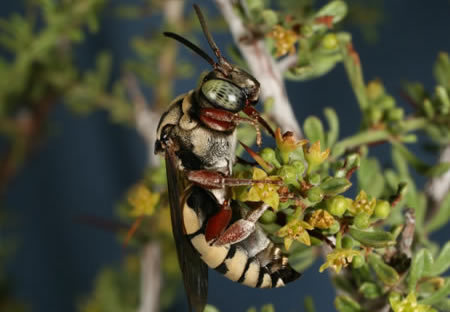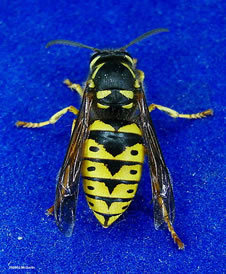What Stings?
You may be a gardener, or have been out for a hike or gone on a picnic and seen an insect wondering whether it was a bee or a wasp. It’s not always easy to tell, certain ones even fool the experts, called entomologists.
What do the bees and wasps look like?
What is a bee?
- Bumble Bee
- Honey Bee
- Cuckoo Bee
Bees

This familiar brown and black insect about ½ inch long (12-15mm) is a European honey bee (Apis mellifera) , a worker bee. This is the champion bee pollinator of commerce, the most often managed pollinator for the majorityt of our crops. She lives in a nest made of beeswax hidden away inside a hollow tree, rock cavity or underground in an abandoned burrow made by another animal. They are social. There is a queen, a few hundred drones (the males), and as many as 40,000 of her sisters, other worker bees. With many pounds of honey, bee bread (pollen) and tender larvae in the nest, this is a ripe target for bears, skunks and other predators. If provoked, the bees will defend their nest by stinging. Each bee can only sting once. Honey bees are unusual because they have barbed stings, which catches in flesh, and the bee dies within several hours of losing her sting.

Bumble bee are those charismatic fuzzy mostly black and yellow "bumblers" known to gardeners worldwide. Two hundred and fifty species of bumble bees, the genus Bombus, are known. About 47 species are found within the United States. These are social bees, like honey bees, with castes and a queen, but form much smaller colonies. Bumble bee queens mate with males in the fall months and only the newly mated queens overwinter in underground hideaways in a form of insect hibernation. In the spring, these females emerge from their "dens" and begin foraging for nectar and pollen to raise a brood. Soon, her daughters take over the foraging activities while she stays in the nest and lays eggs. The colony grows rapidly but dies out each winter, making bumble bee colonies annual instead of long-lived perennial colonies like the honey bees. Bumble bees are also champion pollinators of native plants and garden favorites. We can thank bumble bees for buzz-pollinating (they literally turn themselves into living tuning forks and buzz (sonicate) pollen out of pored anthers) blossoms that give rise to favorites including blueberries, cranberries, eggplant, and tomatoes. Check NAPPC's Ecoregional Guides and other sources for suggestions about what flowers bumble bees like and how to create pollinator way stations for these essential pollinators. At least four US species of bumble bees have declined rapidly in the past decade possibly due to introduced microbial pathogens.

Cuckoo bees are aren't crazy bees. They get their common name for their type of life history. Worldwide, they represent about 10% of the world's 20,000 bee species. Unlike most bees, cuckoo bee females do not forage for pollen to feed their young. They do visit flowers for energy-rich nectar. Instead, these cleptoparasites patiently wait near the entrances to the nests of other ground-nesting bees, often related species. When these females are "out shopping" at flowers, the cuckoo bee female sneaks in the open entrance to lay one of more of her own eggs on the provisioned food masses created by the nesting female. Unknowingly, the host female has provided the food for her parasites brood. Neat trick! Cuckoo bees have a lifestyle almost identical to cowbirds which sneak eggs into the nests of foster parents. Neat trick! Cuckoo bees are very unlike most bees in their appearance. Most people coming across a cuckoo bee would think it was some type of wasp. Cuckoos usually have sparse hairs, or flattened hairs that are more like scales. Their exoskeletons are thickened giving them armor plating from stings of other bees. They also typically have longer stings that most other bees.
Wasps

The colorful yellow and black-striped insect is a true wasp, a “yellow jacket” (the genera Vespula and Dolichovespula). Some of these are native insects and some have been introduced (e.g. the German wasp and the common wasp; Vespula germanica and Vespula vulgaris) from Europe and now widely established). Often mistaken for bees, and sometimes called “meat bees” these common half inch long wasps are frequent unbidden guests to picnics and outdoor events where food is displayed. Every had one buzz your ham or tuna fish sandwich? Yellow jackets are important predators of pest insects, especially caterpillars. If you are growing a vegetable garden these wasps can be your allies. Of course, if you have planted a butterfly garden, having yellow jackets swoop away with your caterpillars isn’t such a good idea. So, please tolerate these beneficial wasps, but if you have too many close to your house making outdoor dining a problem, you might want to try a baited wasp trap.
Here’s a do-it-yourself link:
Bee vs. Wasp?
It’s not always easy to tell a wasp from a bee, even for the experts. About 90% of our native bees are ground-nesting and the remaining 10% living in wood or dead stems (e.g. cane brambles). Most wasps are also ground-living. In general, many but not all wasps have a characteristic “wasp waist” that hourglass figure, a constriction between the thorax and abdomen. This is especially prominent in the yellow mud dauber, or Ammophila the tool-using wasp. Usually, bees are robust and very hairy (like a bumble bee), while wasps are slender and not as hairy as bees. There arer exceptions to this rule. Some parasitic bees (called cuckoo bees or cleptoparasites) are nearly hairless and resemble wasps. Bees always have at least a few branched, called plumose, hairs somewhere on their bodies. These trap pollen grains and aid the females in carrying their pollen loads back to the nest. Wasps don’t have branched hairs. You’ll need a high-powered hand lens or microscope to see this anatomical character. Stings (the aculeus) are a feature of bees, wasps and ants, the group scientists call the Aculeata. Only females have stingers and sting, males don’t. Some bees have lost their stings during their evolutionary history.
How to avoid being stung.
Be cautious when you are near a known bee or wasp nest, especially those in the ground. If you see frequent two way traffic (not just a lone insect) flying in and out of a burrow you can be sure you’ve located a nest.. For honey bees, certain stimuli can trigger a defensive response from a colony. The closer you are to the nest the more you may be stung. Rapid motion and the carbon dioxide in our breath can stimulate the guard bees to come out and investigate. Black, red or similar dark colors should be avoided around bee nests. Think of the Pillsbury Doughboy look, the white coveralls of beekeepers. They are trying to be “anti-bear.” Don’t flail at bees. That lone bee will likely go away unless you swat at it. Honey bees often give you a warning. If a honey bee flies into you, bounces off your head, you need to back off, you’re likely near a nest. This behavior usually happens before they start stinging. Honey bees, bumble bees and other bees are not at all dangerous when visiting flowers. You can observe them up close and take photographs without fear. Enjoy watching them as they pile on the pollen and drink nectar from colorful blossoms.
What to do if you're stung (Envenomation)
These comments were written for dealing with honey bee stings. If a honey bee stings you, take time to find the stinger. You will see a small brown object protruding from the skin. With the edge of a knife or credit card, carefully scrape the stinger out. Do not pinch it ouch with your fingers since this will force more venom in. If you do this within 30 seconds of the sting, you won’t get a full dose of the venom. Wash the sting site with soap and water. If you are stung on the hand while out hiking, put the hand in your pocket which helps mask the alarm pheromone (smells like bananas) from other guard bees. Walk calmly, but put some distance between yourself and the bee nest. If you are attacked by dozens of bees, protect your eyes and face (duck into your tee shirt). Seek shelter. Get insdie a house or a car with the windows up. The bees will not follow you. Do not jump into a lake or swimming pool. The bees will be there waiting for you when you come up for a breath.
Warning Signs of a Medical Emergency
Especially in the case of Africanized honey bees, there is the real threat of a mass stinging involving hundreds or thousands of bees. This can be life-threatening. Although a tiny fraction (< 1%) of the US population is actually Allergic to bee venom, if you are stung hundreds of times, even the healthiest adult may be in trouble due to venom toxicity and organ failure. Some people develop what doctors call “large large reactions.” This could occur if you were stung on the hand and later got reddening (erythema) and swelling (edema) up to your elbow. While this isn’t pleasant, itching etc., it is not a life-threatening situation. Simple aspirin and Benadryl will help. Ask your primary care physician if you have questions. If, however, you or a loved one are stung and within the following one Hour experience difficulty breathing, nausea or vomiting, this is serious. This indicates that the sting victim is going into anaphylactic shock. Get medical attention immediately! Call an ambulance or drive them to a nearby hospital. This must be done in one hour or less. For such sensitized individuals, they may want to get a prescription for an “Epipen” containing epinephrine.